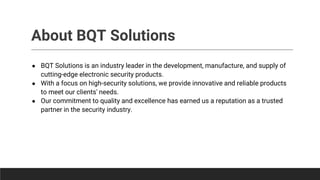Top Fads in Access Control Systems Manufacturers and Their Impact on Security Equipment
Top Fads in Access Control Systems Manufacturers and Their Impact on Security Equipment
Blog Article
Exploring the Function of Access Control Systems in Enhancing Security Tools Performance and Effectiveness
Gain access to control systems are significantly identified as important parts in the landscape of safety and security administration, giving a structured technique to control accessibility to delicate areas and details. Their ability to integrate with various protection innovations, such as monitoring video cameras and alarm, significantly boosts the general effectiveness and effectiveness of safety and security procedures. Nonetheless, as organizations navigate the intricacies of implementation and management, various challenges develop that warrant consideration. What ramifications do these obstacles hold for the future of security methods and modern technologies?
Understanding Gain Access To Control Equipment
Gain access to control systems play a vital role in guaranteeing the protection of different settings, from company offices to sensitive federal government facilities. These systems manage who can get in or exit a designated area, thus protecting properties and sensitive info. The essential components of access control systems consist of authentication, identification, and authorization procedures.
Recognition entails confirming an individual's identification, generally via qualifications such as crucial cards, biometric data, or passwords. When determined, verification confirms the individual's right to access, frequently via multi-factor verification approaches to boost safety. Permission identifies the degree of gain access to given, allowing for separated permissions based on functions within the organization.
Accessibility control systems can be categorized right into 2 major kinds: sensible and physical. Physical accessibility control refer to concrete locations, while logical access control governs electronic details systems. Both kinds work synergistically to provide thorough security remedies.
Combination With Protection Technologies
The assimilation of accessibility control systems with other protection technologies is vital for creating an all natural security setting. By incorporating access control with video surveillance, invasion detection, and security system, companies can boost their overall safety and security position. This interconnected structure enables real-time tracking and fast action to safety cases, boosting situational awareness and functional performance.
As an example, incorporating accessibility control with video security enables safety workers to confirm accessibility events visually, making certain that just licensed individuals are granted access. When gain access to control systems are connected to alarm systems, any unauthorized access efforts can set off prompt notifies, motivating quick action.
Furthermore, the combination of accessibility control with cybersecurity measures is increasingly essential in securing physical possessions and delicate data. By straightening physical security protocols with IT protection systems, companies can guarantee that both electronic and physical access points are checked and regulated properly.
Benefits of Boosted Safety And Security Workflow

Furthermore, improved security procedures help with real-time surveillance and occurrence action. With incorporated systems that incorporate monitoring cameras, alarms, and gain access to controls, protection teams can promptly recognize and attend to possible hazards. This aggressive strategy enables timely treatments, lowering the chance of protection breaches and prospective losses.
In addition, reliable security procedures add to a society of safety and security within the organization. Employees are likely to feel even more secure when they recognize that durable procedures are in location, bring about raised morale and productivity. The use of data analytics from access control systems enables organizations to examine security fads, boost policies, and assign sources successfully.
Factors To Consider and obstacles

In addition, organizations must resolve the capacity for information breaches. Access control systems typically manage delicate information, and any kind of susceptabilities can expose this information to unauthorized gain access to. custom security solutions. Guaranteeing durable cybersecurity steps is crucial to secure against such threats
User training is another vital consideration. Employees must comprehend exactly how to make use of accessibility control systems efficiently, as incorrect usage can bring about protection spaces. Furthermore, companies must balance safety with individual ease; extremely limiting access can impede performance and result in workarounds that compromise security procedures.
Conformity with legal and governing needs is additionally paramount. Organizations should guarantee that their accessibility control systems meet market standards and regional laws, which can differ substantially. The ongoing upkeep and monitoring of these systems call for specialized sources, making it important for organizations to allot proper budgets and personnel to ensure long-term effectiveness and efficiency.

Future Trends in Access Control
Anticipating the future of accessibility control reveals a landscape significantly shaped by technological improvements and advancing security demands. One substantial fad is the integration of synthetic intelligence (AI) and maker learning, which enhance decision-making abilities and automate threat detection. These innovations enable real-time evaluation of gain access to patterns, enabling more flexible and responsive safety and security actions.
Biometric authentication is also obtaining traction, with advancements in finger print, facial acknowledgment, and iris scanning innovations using improved safety and user convenience. As these systems come to be much more advanced and affordable, their adoption throughout different markets is anticipated to rise.
One more emerging pattern is the change in the direction of cloud-based gain access to control systems. These remedies give scalability, remote administration, and centralized data storage space, permitting organizations to improve and streamline procedures efficiency.
In Addition, the Web of Points (IoT) is established to change access control by enabling interconnected tools to connect and share data, thus improving situational awareness and protection responsiveness.
Final Thought
To conclude, access control systems significantly boost the performance and efficiency of safety devices by helping with precise recognition, authentication, and permission procedures (customized security solutions). Their assimilation with monitoring and alarm system systems cultivates an aggressive safety and security atmosphere that deals with prospective violations in real-time. While obstacles and factors to consider exist, the recurring advancement access control systems manufacturers of accessibility control innovations promises to further enhance protection procedures. Eventually, these systems are important to guarding sensitive locations and details within companies, guaranteeing a durable security structure.
Access control systems are increasingly identified as vital components in the landscape of security administration, providing an organized approach to control accessibility to sensitive areas and information. Physical access control pertains to tangible places, while logical access control governs electronic details systems.The assimilation of gain access to control systems with various other safety innovations is essential for producing an alternative protection setting. Accessibility control systems typically deal with sensitive information, and any type of vulnerabilities could subject this information to unauthorized gain access to. Companies must stabilize safety and security with user convenience; overly restrictive access can prevent efficiency and lead to workarounds that compromise safety and security procedures.
Report this page